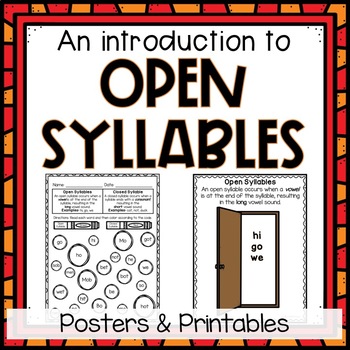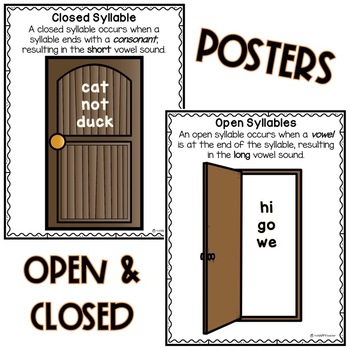Open Syllable Worksheets
TheHappyTeacher
15k Followers
Grade Levels
K - 2nd
Subjects
Resource Type
Standards
CCSSRF.K.2
CCSSRF.K.2b
CCSSRF.1.2
CCSSRF.1.2a
CCSSRF.1.3b
Formats Included
- PDF
- Easel Activity
Pages
7 pages
TheHappyTeacher
15k Followers
Easel Activity Included
This resource includes a ready-to-use interactive activity students can complete on any device. Easel by TPT is free to use! Learn more.
What educators are saying
This was a great package to supplement my UFLI lessons! Lots of great, engaging activities are included!
This is a quick and simple resource that can be used a quick check for student's understanding. They were able to successfully distinguish between open and closed syllables.
Description
Introduce students to open syllables with these no-prep printables and posters. Students will learn that an open syllable occurs when a vowel is at the end of the syllable, resulting in the long vowel sound. Print and hang the open door poster to remind students that when the syllable is open, the vowel will be long.
This resource includes three worksheets for student practice.
- Identifying open syllables vs. closed syllables
- Sorting open syllables by long vowel sounds
- Nonsense word sort: open vs. closed syllables
Take a look at the preview to see exactly what's included in this introduction to open syllables. If you have any questions, please e-mail me at TheHappyTeacherTPT@gmail.com
You may also like...
Adjective Surprise: What's in the bag?
Total Pages
7 pages
Answer Key
N/A
Teaching Duration
N/A
Report this resource to TPT
Reported resources will be reviewed by our team. Report this resource to let us know if this resource violates TPT’s content guidelines.
Standards
to see state-specific standards (only available in the US).
CCSSRF.K.2
Demonstrate understanding of spoken words, syllables, and sounds (phonemes).
CCSSRF.K.2b
Count, pronounce, blend, and segment syllables in spoken words.
CCSSRF.1.2
Demonstrate understanding of spoken words, syllables, and sounds (phonemes).
CCSSRF.1.2a
Distinguish long from short vowel sounds in spoken single-syllable words.
CCSSRF.1.3b
Decode regularly spelled one-syllable words.






